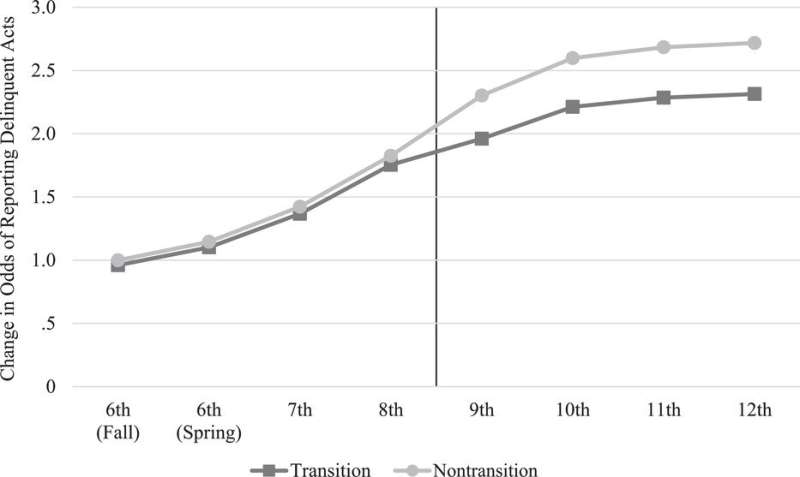In the transition to high school, eighth graders who move to a new building were less delinquent than peers who stayed

Levels of crime and delinquency vary considerably with age, peaking around age 15 before diminishing considerably by the mid- to late-20s. As youth's involvement in delinquency rises, most transition from middle school to high school, typically at a new location.
A new study of middle and high school students examined the degree to which moving to a new high school building between eighth and ninth grade (compared to staying in the same building during these years) affected adolescent delinquency. The study found that students who moved to a new school location reported significantly less delinquency after the shift than those who did not.
The study, by researchers at Randolph-Macon College, Pennsylvania State University, and Northeastern University, appears in Criminology.
"Our findings highlight the role of a crucial yet understudied life transition in shaping adolescent delinquency," notes Brittany N. Freelin, assistant professor of criminology at Randolph-Macon College, who led the study. "They also underscore the potential of changing social context to reduce juvenile delinquency in high school."
Important life transitions, such as starting to date, having a parent go to jail, and joining a gang, shape young people's participation in crime. Most (12,000 of 13,800) U.S. public schools move students to new high school buildings after middle school. This transition from middle to high school is a critical time, yet little research has studied the effect of this major change on juvenile delinquency.
In a quasi-experiment, researchers examined more than 14,000 primarily White students in 26 public school districts who were part of the Promoting School-Community Partnerships to Enhance Resilience (PROSPER) study. All districts were in rural communities or small towns in Pennsylvania or Iowa.
To be eligible, districts had to enroll 1,300 to 5,200 students, with at least 15% eligible for free or reduced-price lunch. Half of the districts were randomly assigned to participate in a substance abuse prevention program that included school- and community-based components in sixth through seventh grade.
The study measured individual students' delinquency by considering their responses to 12 survey items on their past-year participation in delinquent behaviors; these included taking something that did not belong to you, beating up someone, damaging or destroying someone's property, breaking into a building, throwing objects to hurt or scare people, running away from home, skipping school, and shoplifting.
Students were followed over eight waves from sixth through 12th grade, which allowed researchers to directly compare students who changed schools after eighth grade with students who remained at the same school after eighth grade. Twenty-two of the districts transitioned students to a new high school; the four districts that did not move students to new buildings for high school served as controls.
Students who transitioned between schools reported significantly less delinquency after the shift than those who did not, and this difference persisted through 10th grade. The decline in delinquency was most pronounced when adolescents from several middle schools moved to a single high school (i.e., multifeeder transitions). Students who transitioned to a new school had fewer delinquent friends and participated in less unstructured socializing following the change in school environment, which partially mediated their reduced delinquency.
"More than 700,000 adolescents in the United States are arrested every year for delinquent offenses, such as stealing, fighting, and property damage," explains Cassie McMillan, assistant professor of sociology, criminology, and criminal justice at Northeastern University, who coauthored the study. "A key implication of our findings is that middle school students who have already been identified as offenders might be better off changing school settings than remaining in the same social and academic environment."
The transition to a new academic setting might be a "shock" to the social environment surrounding an adolescent, which in turn could reduce levels of juvenile delinquency in the long run, the authors suggest. They also suggest that efforts to facilitate students' formation of friendships and involvement in structured extracurricular activities as they adjust to the context of a new school might be beneficial.
The study's authors note that the school districts they examined are not nationally representative (e.g., they do not include large urban communities and concentrated minority populations).
But while their findings may not generalize to other settings, they point out that residents of the districts studied have relatively limited school choice, which reduces the chance that the effects of transitions are the result of individual-level selection. In addition, while the study considered many behaviors, high school transitions likely shape additional risky behaviors that were not examined (e.g., smoking, drinking, other types of substance use).
More information: Brittany N. Freelin et al, Changing contexts: A quasi‐experiment examining adolescent delinquency and the transition to high school, Criminology (2022). DOI: 10.1111/1745-9125.12320
Journal information: Criminology
Provided by American Society of Criminology




















